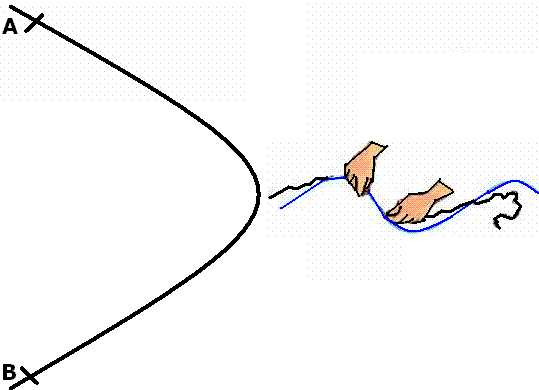

Which property of the constituents of a mixture is used in winnowing?
Difference in weights of the constituents leads to their separation by winnowing.
(ii) The stem provides support to the branches, leaves, flowers and fruits.
what do you understand by luminous objects? Give two examples.
The objects, which emit light, are called luminous objects.
Example: Sun & Torch.
(b) Internode: The portion of the stem between two nodes is called internode
Materials which are lighter than water, float on water. Wood and oil are lighter than water and float on it.
What are shadows?
When light falls on an opaque object, it cast a dark patch called shadow of that object.
Name a gaseous mixture. Mention its constituents also.
Air is a gaseous mixture. It contains nitrogen, oxygen, carbon dioxide, water vapours and other gases like hydrogen, helium, etc.
Vitamins are complex organic compounds,which are essential for the growth of our body. They do not provide energy.
Vitamin A keeps our skin and eyes healthy.
Vitamin C helps the body to fight against diseases.
| Translucent objects | Transparent objects |
| 1. They allow the light to pass partially through them. | 1. They allow light to pass completely through them. |
| 2. Objects through them can't be seen clearly. | 2. Objects through them can be seen clearly. |
| 3. Butter paper and wax paper are examples of translucent objects. | 3. Glass and Air are examples of transparent objects. |
(i) Ginning
(ii)Spinning
(iii) Knitting
(i) Ginning is the process of removal of cotton seeds from cotton.
(ii)Spinning is the process of making yarn from fibres.
(iii) Knitting is a process in which a single yarn is used to make a piece of fabric.
a) The motion of man on a straight road.
b) The motion of wheels of a car .
c) The motion of a falling stone.b) The motion of wheels of a car is an example of circular motion.
c) The motion of a falling stone is an example of rectilinear motion.Write three advantages of grouping.
1. It helps in gaining systematic knowledge of things.
2. It gives a general idea about all members of a group and the differences between members of different groups.
3. It is convenient to work with all members of a group knowing their properties.
Answer the following questions:
1. How is common salt obtained from sea water?
2. How will you separate sugar from a mixture of wheat flour and sugar?
1. Sea water is allowed to stand in shallow pits. Due to solar heat, water in the pits gets heated up and slowly evaporates. After few days, when all of the water has evaporated, the solid salt (common salt) is left behind in the pits. The salt in the pits is further purified to get pure common salt.
2. Sugar can be separated from the mixture of wheat flour and sugar by the sieving process. The mixture is poured on a sieve. The fine particles of wheat flour pass through the holes of the sieve and the sugar particles being bigger in size remain on the sieve. In this way, sugar gets separated from wheat flour.
Give two examples of each:
(a)
(b)
(c)
(a) Potatoes and Cereals
(b) Fish and Pulses
(c) Butter and Oil
Describe the method for measuring the length of a curved line?
Let’s understand this problem with the help of an example.
We have a curved surface as shown in the figure below,

Here we have to measure the length of the curve from point A to point B as shown in the figure. For this first of all we have to take a thread of length greater than distance between A and B points.
Now move the thread along the path of the curved surface between points A and B. Mark the thread at the end point up to which you want to measure the length (Point B in this case).
Place the thread on the scale starting from zero to the marked end point. Measure this length by the help of the scale. This length will give the length of the curved line AB.
Classify the following fibres as animal fibre and plant fibre. Write the name of their source also.
(i) Silk is an animal fibre. It is obtained from silk worm.
(ii) Cotton is a plant fibre. It is obtained from cotton plant.
(iii) wool is an animal fibre. It is obtained from fleece of sheep or hair of yak.
(iv) Coir is a plant fibre. It is obtained from coconut tree.
(i)Appearance: Appearance of a material is compared in terms of colour, lustre, texture or physical state. A metal spoon shines whereas a wooden spoon does not shine. Materials that have lustre are called metals. Eg: copper, aluminium, gold etc.
(ii) Hardness
Soft materials: The materials that can be compressed or scratched easily are called soft. For example cotton, sponge.
Hard materials: The materials that cannot be compressed or scratched easily are called hard. For example, iron.
(iii) Solubility: Substances that disappear or dissolve completely in water are called soluble substances. For example, salt, sugar etc.
The substances that do not dissolve completely in water even after stirring for a long time are called insoluble substances. For example, chalk powder, saw dust etc.
(iv)Transparency
Transparent Materials: Substances through which things can be seen are transparent materials. For example, glass, water etc.
Opaque Materials: Substances through which things cannot be seen are opaque materials. For example, wood, iron etc.
Translucent Materials: The materials through which objects can be seen, but not clearly are known as translucent materials. For example, butter paper etc.
(v)Floating property: Some objects float on water while other sink in it. An object will float or sink in water depends on whether it is lighter or heavier than water.Materials lighter than water floats, e.g., plastic, pencil etc. Materials heavier than water sinks, e.g., iron nail, steel etc.
Which property of the constituents of a mixture is used in winnowing?
Difference in weights of the constituents leads to their separation by winnowing.
(ii) The stem provides support to the branches, leaves, flowers and fruits.
what do you understand by luminous objects? Give two examples.
The objects, which emit light, are called luminous objects.
Example: Sun & Torch.
(b) Internode: The portion of the stem between two nodes is called internode
Materials which are lighter than water, float on water. Wood and oil are lighter than water and float on it.
What are shadows?
When light falls on an opaque object, it cast a dark patch called shadow of that object.
Name a gaseous mixture. Mention its constituents also.
Air is a gaseous mixture. It contains nitrogen, oxygen, carbon dioxide, water vapours and other gases like hydrogen, helium, etc.
Vitamins are complex organic compounds,which are essential for the growth of our body. They do not provide energy.
Vitamin A keeps our skin and eyes healthy.
Vitamin C helps the body to fight against diseases.
| Translucent objects | Transparent objects |
| 1. They allow the light to pass partially through them. | 1. They allow light to pass completely through them. |
| 2. Objects through them can't be seen clearly. | 2. Objects through them can be seen clearly. |
| 3. Butter paper and wax paper are examples of translucent objects. | 3. Glass and Air are examples of transparent objects. |
(i) Ginning
(ii)Spinning
(iii) Knitting
(i) Ginning is the process of removal of cotton seeds from cotton.
(ii)Spinning is the process of making yarn from fibres.
(iii) Knitting is a process in which a single yarn is used to make a piece of fabric.
a) The motion of man on a straight road.
b) The motion of wheels of a car .
c) The motion of a falling stone.b) The motion of wheels of a car is an example of circular motion.
c) The motion of a falling stone is an example of rectilinear motion.Write three advantages of grouping.
1. It helps in gaining systematic knowledge of things.
2. It gives a general idea about all members of a group and the differences between members of different groups.
3. It is convenient to work with all members of a group knowing their properties.
Answer the following questions:
1. How is common salt obtained from sea water?
2. How will you separate sugar from a mixture of wheat flour and sugar?
1. Sea water is allowed to stand in shallow pits. Due to solar heat, water in the pits gets heated up and slowly evaporates. After few days, when all of the water has evaporated, the solid salt (common salt) is left behind in the pits. The salt in the pits is further purified to get pure common salt.
2. Sugar can be separated from the mixture of wheat flour and sugar by the sieving process. The mixture is poured on a sieve. The fine particles of wheat flour pass through the holes of the sieve and the sugar particles being bigger in size remain on the sieve. In this way, sugar gets separated from wheat flour.
Give two examples of each:
(a)
(b)
(c)
(a) Potatoes and Cereals
(b) Fish and Pulses
(c) Butter and Oil
Describe the method for measuring the length of a curved line?
Let’s understand this problem with the help of an example.
We have a curved surface as shown in the figure below,

Here we have to measure the length of the curve from point A to point B as shown in the figure. For this first of all we have to take a thread of length greater than distance between A and B points.
Now move the thread along the path of the curved surface between points A and B. Mark the thread at the end point up to which you want to measure the length (Point B in this case).
Place the thread on the scale starting from zero to the marked end point. Measure this length by the help of the scale. This length will give the length of the curved line AB.
Classify the following fibres as animal fibre and plant fibre. Write the name of their source also.
(i) Silk is an animal fibre. It is obtained from silk worm.
(ii) Cotton is a plant fibre. It is obtained from cotton plant.
(iii) wool is an animal fibre. It is obtained from fleece of sheep or hair of yak.
(iv) Coir is a plant fibre. It is obtained from coconut tree.
(i)Appearance: Appearance of a material is compared in terms of colour, lustre, texture or physical state. A metal spoon shines whereas a wooden spoon does not shine. Materials that have lustre are called metals. Eg: copper, aluminium, gold etc.
(ii) Hardness
Soft materials: The materials that can be compressed or scratched easily are called soft. For example cotton, sponge.
Hard materials: The materials that cannot be compressed or scratched easily are called hard. For example, iron.
(iii) Solubility: Substances that disappear or dissolve completely in water are called soluble substances. For example, salt, sugar etc.
The substances that do not dissolve completely in water even after stirring for a long time are called insoluble substances. For example, chalk powder, saw dust etc.
(iv)Transparency
Transparent Materials: Substances through which things can be seen are transparent materials. For example, glass, water etc.
Opaque Materials: Substances through which things cannot be seen are opaque materials. For example, wood, iron etc.
Translucent Materials: The materials through which objects can be seen, but not clearly are known as translucent materials. For example, butter paper etc.
(v)Floating property: Some objects float on water while other sink in it. An object will float or sink in water depends on whether it is lighter or heavier than water.Materials lighter than water floats, e.g., plastic, pencil etc. Materials heavier than water sinks, e.g., iron nail, steel etc.

Take your CBSE board preparation to another level with AI based and rich media animation on Extramarks - The Learning App.
Features of Learning App